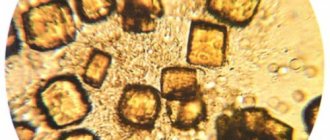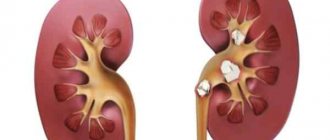Bacteria in a child's urine is not yet a reason to panic, but if there are too many of them and they exceed the norm, this may warn of serious problems. It is important to exclude possible violations at the analysis collection stage. They often cause an excess of microorganisms in the sample.
Most parents are interested in how bacteriuria manifests itself and is diagnosed, and ways to combat it.
Bacteria in urine in children
A variety of microbes are present in the body of any child, and this is normal if they are in acceptable quantities. Most of them are absolutely harmless, but there are also those that, when the immune system is weakened, can cause disturbances and provoke the development of a systemic infection.
A pathological phenomenon is considered if the concentration of bacteria in one milliliter of urine exceeds 100 units.
This condition is called bacteriuria and requires medical intervention. There is even a table and transcript that shows acceptable urine values for different ages.
Excess bacteria is a sign of infectious inflammation in the urinary system: kidneys, bladder or ureter. It is impossible to hesitate when identifying such pathologies.
In children, bacteria are present in small quantities in the bladder and urinary tract. This is the norm, but they never occur in the ureter. If they get there, this confirms the development of serious and health-hazardous disorders.
The presence of non-pathogenic, pathogenic and opportunistic microorganisms in the urine causes the development of inflammatory processes under the influence of external factors. As soon as the body weakens, the immune system does not protect it from hypothermia, injury, or the development of diseases; microbes become active and begin to multiply intensively.
Determination of bacteria in urine
Important! Bacteria may be detected in a urine sample if it was collected incorrectly. Microorganisms can enter the material from the genitals (with insufficient processing before collecting samples, in the presence of balanoposthitis or vulvovaginitis, other inflammations of this area), when squeezing urine from a diaper or diaper, when collecting on oilcloth, or using non-sterilized secondary utensils.
In this case, during bacterial culture of urine, many different colonies are sown. The doctor will definitely prescribe a repeat urine test.
Identification
The type of bacteria and their sensitivity to antibiotics are determined using microscopy of urinary sediment and bacterial culture of urine on nutrient media. This method also monitors the response to treatment.
By microscopy, bacteria are identified by their characteristic appearance.
A morning sample of urine collected in a sterile container after thoroughly washing the child without using soap or antiseptics is suitable for this analysis. The urine sample must be brought to the laboratory no later than two hours later.
If, after sowing in a favorable nutrient medium, a colony of microorganisms germinates, the result is considered positive. Concentration, i.e. the quantitative expression of bacteria per unit volume of urine, is usually calculated in colony-forming units (CFU). You can also find the designation CFU (colony-forming unit) - this is one cell that can give rise to the growth of a colony.
Indicators
With true bacteriuria (microorganisms grow and develop in the urinary system), the predominant colony of the pathogen is clearly determined in the bacterial culture.
In pediatrics, bacteriuria is defined as the release of 50,000 colony-forming units (CFU) of a uropathogen per ml of urine. Results vary slightly depending on how the urine was collected (see table).
Retrospective indicator in 1 ml of urine
| Index | Spontaneously excreted urine | Medium stream of urine or stream obtained through a catheter | Urine obtained through a suprapubic catheter | |
| Girls and boys under 3 years old | Boys over 3 years old | |||
| White blood cell count | ||||
| Norm | < 20 | < 15 | < 5 | < 5 |
| Expected | 20–50 | 15–50 | 5–10 | 5–10 |
| Pathology | > 50 | > 50 | > 10 | > 10 |
| Number of bacterial cells | ||||
| Norm | < 104 | < 103 | < 103 | Sterile |
| Expected | 104 | 103 to 5x104 | 103 to 5x103 | Sterile |
| Pathology | > 105 | > 5x104 | > 5x103 | Any presence |
Routine checks sometimes reveal minor bacteriuria in apparently healthy children - in approximately 0.2-2% of cases. This is called asymptomatic bacteriuria, which occurs without clinical manifestations and does not require treatment with antibiotics.
Determination of sensitivity
To rationally prescribe antibiotics, the sensitivity of the cultured pathogen to the action of the drug is initially determined. This need is due to developing bacterial resistance.
The principle of determining sensitivity to antibiotics
In the laboratory, bacterial colonies will be exposed to antibiotics of various groups. In addition to finding out which drug most effectively fights the infection, they will determine its minimum inhibitory concentration. In pediatric practice, this is very important, because the child’s body reacts sharply to aggressive drugs and it is important for the doctor not to harm the prescribed treatment.
Varieties
In medicine, there are two types of conditions in which microorganisms are present in the urine: true and false bacteriuria. The first condition is noted in the presence of pathogenic microflora in the urine, when it spreads and multiplies in the organs of the urinary system. By forming colonies in the urethra, bladder, and kidneys, bacteria lead to the development of diseases such as urethritis, cystitis, glomerulonephritis or pyelonephritis.
Factors causing the occurrence of pathologies are:
- stagnation of urine, formed due to prolonged spasm or obstruction of its outflow - salts, sand, stones;
- ureteral or renal reflux - backflow of urine into the kidneys or ureters;
- concomitant diseases - multiple foci of infection accompanied by the formation of pus, autoimmune diseases, diabetes mellitus;
- frequent hypothermia, the presence of stressful situations at home or in preschool or educational institutions;
- persistent decrease in the protective function of the immune system.
False bacteriuria is a consequence of pathogens entering the urinary tract, but due to good immunity or taking antibiotics, their reproduction does not occur. This condition can only be detected by performing a urine test, which will reveal that the bacteria content is elevated.
Possible reasons
The presence of bacteria in a child's urine can occur for a variety of reasons. Among the harmless and non-dangerous, incorrect results should be distinguished. This occurs if the material collection process was disrupted. But if the results are reliable and the microorganisms actually exceed the norm, this may indicate pathologies.
To confirm or refute the result, a second sample is taken and the urine is examined.
The collection is carried out according to all rules in compliance with hygiene. After receiving a repeated positive result, it is important to identify how the microorganisms entered the body. There are only two ways here:
- descending, when bacteria are brought into the bladder and ducts from the upper sections;
- ascending if bacteria from the lower parts (genital organs) end up in the urine.
The second important step is to determine where and why the infection came from. The reasons for this are different. She could have gotten there after medical intervention or manipulation using unsterile instruments.
Another reason may be failure to comply with personal hygiene rules, which is especially true for girls. Due to the location of the genital organs, their risk of infection is higher than that of boys.
The causes of bacteria in a child’s urine can also be:
- swimming in cold water;
- injuries;
- inflammatory processes of soft tissues;
- any kind of hypothermia;
- masturbation;
- masturbation.
To begin treatment and reduce the level of bacteria in the urine to an acceptable level, it is important to find out the reasons for their entry.
Features of bacteriological analysis
In a conventional urine test, bacteria can only be detected by microscopy of the sediment. In most cases, the following indicators are considered: leukocytes, erythrocytes, protein. The norm for leukocytes is 3-5 per field of view, not higher, and they are represented by neutrophils.
When the concentration of leukocytes increases and mucus appears, a urine test is usually prescribed for a tank. sowing. During it, you can accurately find out the causes of mucus and detect bacteria in the child’s urine.
In some cases, they offer to do a rapid test, which determines whether the urine contains nitrites. The principle of the test is that nitrates present in normal urine are converted into nitrites in the presence of pathogenic flora.
Nitrites in a child’s urine mean one thing – bacteria are present.
But this analysis is not very informative; in 50% of cases it gives a false negative result:
- Most species of gram-positive bacteria do not have enzymes that convert nitrates to nitrites;
- If urine remains in the bladder for less than 4 hours, bacterial conversion is not possible.
Therefore, if leukocytes are found in a child’s urine, bacteria should be looked for using a regular bacterial culture, which should take from 5 days to a week.
Urine tank test. Cultures can indicate the likelihood of the following problems:
- inflammatory processes in the urinary system;
- ureter or bladder infections;
- urethritis.
It also gives an answer during treatment, whether the regimen used is effective - it is done for the purpose of control.
Treatment does not begin without interpreting what bacteria have been found and their sensitivity to antibiotics - another analysis is done for this. Most often, pathogenic flora of one type is detected, but several types of pathogenic bacteria can be present in the urine at the same time.
The most common forms include the following:
- Enterococcus faecalis;
- Escherichia Collie;
- Proteus and Lactobacillus;
- Klebsiella pneumonia.
Prevention
Urinary tract infections often occur due to poor hygiene. For example, washing girls should be done only from the vagina towards the anal area. In the same way, you need to wipe your child with paper or a napkin after bowel movements. This will prevent microbes from the intestines from reaching the baby’s genitals, from where they can easily enter the urethra and higher up the urinary tract.
Another measure to prevent diseases of the urinary system is regular urine testing, because quite often infections occur without any warning symptoms. The child may also not be able to explain his feelings or be embarrassed. That is why a general urine test once a year is recommended for all children.
Of course, a doctor should treat such a condition.
- elimination of the source of infection after a diagnostic examination;
- complete release of the bladder;
- carrying out antibiotic therapy depending on the type of bacteria, and always with a wide spectrum of action;
- dietary nutrition is the main method of treatment;
- concomitant herbal treatment - herbal medicine from infusions and teas of lingonberry leaves, calendula, oats;
- a course of therapeutic baths using pine extract;
- normalization of stool, control of intestinal cleansing;
- Carrying out personal hygiene for the baby - personal towel, soap, toothbrush;
- Inpatient treatment is mandatory in order to see the dynamics of recovery and obtain normal urine test results.
All treatment to eliminate a bacterial infection is aimed at neutralizing the causative agent of the source of infection, improving urine tests and the general condition of the baby. An important result of treatment is the normal amount of urination, and following a diet for at least 3 months will consolidate the result.
Parents should not ignore routine medical examinations; they are carried out for a reason.
These are the first steps towards strengthening and monitoring the baby’s health.
Symptoms
It is difficult to recognize bacteriuria by external signs even in an adult. In children this is not at all easy, because they, as a rule, do not complain about changes in well-being. A small child will not say that he feels pain or discomfort when urinating, so special attention is paid to collecting anamnesis and conversation before prescribing a diagnosis.
The most common signs of bacteria in urine include the following:
- pain in the lower abdomen;
- discomfort and pain when urinating;
- impurities of blood, mucus, pus;
- lower back pain;
- increase in body temperature.
If you experience any of these symptoms, it is important to immediately seek help from a doctor and get tested.
Symptoms
In most cases, bacteria in a child’s urine is detected with the following symptoms:
- the baby complains of pain in the back and lower abdomen or a burning sensation when urinating;
- babies' character deteriorates, they become restless, cry when urinating;
- sometimes bacteriuria is accompanied by fever.
Sometimes pain during urination provokes reflex urinary retention, which in turn aggravates the severity of the patient’s condition. In this case, the little patient needs competent treatment.
Treatment
How to treat the disease that causes bacteriuria depends on the type of microorganisms and their sensitivity to antibacterial drugs.
In some cases, for example with cystitis, the use of bioactive medicinal plants is a fairly effective remedy:
- bearberry;
- chamomile;
- cranberry;
- wild rosemary
In the absence of kidney pathology, drinking plenty of fluids and using diuretic herbs and drugs that help flush out bacteria are indicated:
- dill;
- parsley;
- celery (including juice).
Among women suffering from chronic cystitis and during pregnancy, a natural remedy, Phytolysin, is very popular. Herbal medicine can be used as a method of self-medication in children and pregnant women, provided there are no allergies or individual intolerances. Do not forget that any self-medication is a serious and responsible step, so at least consulting a doctor is necessary.
Drug therapy and dosage of the drug are selected individually, depending on the patient’s age, health status, concomitant diseases and conditions.
The following types of drugs can be used:
- Monural.
- Nolitsin.
- Sumamed.
- Nitroxoline.
- Furagin.
- Rulid.
- Furadonin.
In the treatment of gonococcal infection, ceftriaxone, ciprofloxacin, and spectinomycin are used. For pyelonephritis - 5-NOK, Palin, Loraxone, Amoxiclav.
The main drugs for the treatment of bacteriuria depending on the underlying cause
Admin
Survey
Due to the fact that there are no symptoms, bacteria in the urine can be detected even when the inflammatory process has caused serious consequences and manifested itself with characteristic signs. In infants, diagnosis is even more difficult; infection can be confused with many disorders.
To accurately establish the diagnosis of bacteriuria, the following methods are used:
- biochemical blood test;
- general urine analysis;
- bacteriological culture;
- Nechiporenko test;
- Zimnitsky test;
- ultrasound examination.
In urine tests in a child with bacteriuria, deviations from the norm in the content of red and white blood cells, the presence of pathogenic microorganisms, and the presence of substances that cannot be there will be recorded.
The fastest way to determine abnormalities is a nitrite test. This rapid test can determine nitrite levels and if bacteria are present, they will be higher than normal. Uropathogenic bacteria produce these substances, and their high levels confirm infection.
To determine the class of pathogenic microbes, urine culture is done. And in order to assess the degree of damage and the functionality of the organs of the urinary system, daily urine is collected for analysis.
Information about bacteriuria
Normally, a child should not have bacteria in his urine - this liquid is absolutely sterile. If the content of bacteria in the urine is more than 105 g/ml, then we can talk about bacteriuria.
A healthy person should not have any foreign impurities in this physiological secretion:
- blood;
- slime;
- pus;
- sediment;
- salts - all this indicates inflammatory processes.
There should also be no red blood cells in the urine. 1-2 in the field of view may indicate kidney stones, a larger number may indicate hematuria.
In case of a large number of epithelial cells, it is better to repeat the urine test. This may indicate that the child was not washed well before collecting urine for analysis.
Bacteriuria can occur without severe symptoms if the patient has a high immune status or is undergoing treatment with antibacterial drugs to eliminate another disease.
This condition is dangerous for the patient himself and those around him - the disease can exist for a long time in a chronic form and manifest itself when pronounced kidney pathologies have already arisen, and besides, the bacteria can infect others.
What examinations should be performed for bacteriuria?
If the initial analysis shows the presence of bacteria in the urine, then you should pay attention to whether the material for analysis was collected correctly. Urine should be collected only in a sterile container. The child's genitals should be washed well immediately before urine collection.
If everything was done correctly, then to make a final diagnosis, doctors prescribe additional tests. These include: analysis according to Nechiporenko, Zemnitsky, urine culture and ultrasound of the kidneys. An effective method for studying the condition of the kidneys is excretory urography. In this case, narrowing, stones and sand in the kidneys are often found. Girls definitely need to be shown to a gynecologist, since the infection in the urinary tract could have gotten from the vagina. This possibility cannot be excluded even in infants.
Using this analysis, you can determine the presence of various microorganisms in the body.
Tips for parents
Direct responsibility for the health of the baby lies with the parents. There are a number of tips to reduce the likelihood of bacteria appearing in your child’s urine:
- If possible, continue breastfeeding for at least 6 months after birth. This supports the baby's immune defense and also prevents constipation.
- Take steps to reduce the likelihood of constipation.
- Make sure your child drinks enough fluids and urinates regularly. Holding urine creates favorable conditions for the development of bacteria in the urinary tract.
- Teach girls to wipe from front to back to help minimize the transfer of bacteria from the rectum to the urethra.
- Avoid underwear made from artificial fabrics, they promote the growth of bacteria. Instead, loose cotton underwear is encouraged.
- Avoid excessive use of scented soap to wash your baby, this can change the composition of the normal microflora of the genital organs.
It is possible that the child will be recommended to undergo clinical observation for some time. Its main activities: monthly monitoring of urine tests; for pyelonephritis - functional tests; regular blood pressure measurement; sanitation of foci of infection, nutrition correction.
Diagnosis of bacteriuria
Depending on the purpose of analysis, various diagnostic methods are used:
- express method (TTX test, Griesser test, glucose reduction test) - these methods require little time, but their results are not informative enough. Used for initial detection of microorganisms.
- bacterial culture of urine. This is a highly accurate method that requires time to process the results.
First, simple diagnostic methods are used, and accurate and complex ones are used when it is necessary to clarify the diagnosis and choose treatment tactics. Therefore, when bacteriuria is detected, the analysis is recommended to be repeated several times.
If the test for bacteriuria is positive, children must undergo an ultrasound of the genitourinary system. X-ray contrast studies of the urinary tract, kidney scintigraphy, and endoscopy can also be performed.











